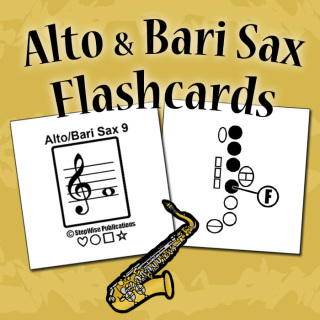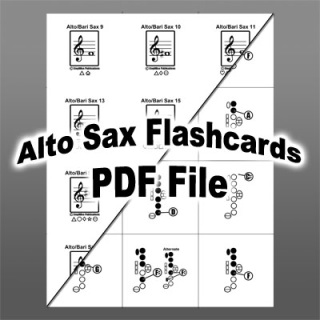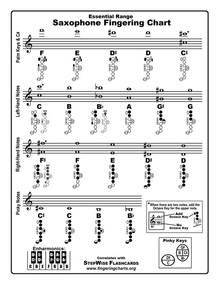How to Play the Alto/Bari Saxophone - Fingering Chart & Flashcards
Notes & Fingerings on the Saxophone - Free Fingering Chart
|
The StepWise saxophone fingering chart is quite different from the chart in the back of most band method books. First of all, it fits all the notes onto one page. Only ONE! That means students can put the page on their music stands and refer to it when they are reading new music and come across notes they can't remember.
You may notice that along the two middle rows of notes there are two notes shown for each fingering. These are octaves which have the same letter name, and are also fingered exactly the same on the saxophone, except for the addition of the "Octave Key" for the higher note. Why do other fingering charts waste so much space and paper showing these notes in two different locations? When they are shown together as the "same" fingering, students learn and memorize the notes faster and make better sense of the fingering patterns on the sax. |
This chart also has a handy "Pinky Key" chart, which makes it easier for music teachers to refer to the keys and for students to figure them out. In order to keep the chart's appearance more simple and visually appealing, only the most common enharmonic is shown. However, there is a small piano keyboard which identifies the enharmonic equivalent on each "black key", and helps beginning saxophone players make sense of the accidentals (sharps & flats) and the enharmonic possibilities.
The StepWise fingering charts are intended for beginning to intermediate musicians who want to memorize the notes in the essential range of each instrument. As such, this saxophone chart shows the essential alternate fingerings, but does not include any altissimo notes. For good information on how to play altissimo notes, visit Taming The Saxophone. For a very clear altissimo fingering chart, visit this Cannonball Saxophone page. Perhaps the ultimate online resource for altissimo fingerings and all possible alternate fingerings on the saxophone is the Woodwind Fingering Guide site.
As a junior high band director, I am concerned about helping my beginners get a good, solid start. One of my most successful strategies is to copy these fingering charts onto card stock and pass them out on the first day of beginning band. It becomes an excellent reference tool and helps everyone make sense of their instruments. You can download and use this chart for free by clicking on the link below.
I would really love to hear your success stories and to receive your suggestions for improvement using the Contact Us heading above. Here's hoping that your saxophonists can learn their notes better than mine!
The StepWise fingering charts are intended for beginning to intermediate musicians who want to memorize the notes in the essential range of each instrument. As such, this saxophone chart shows the essential alternate fingerings, but does not include any altissimo notes. For good information on how to play altissimo notes, visit Taming The Saxophone. For a very clear altissimo fingering chart, visit this Cannonball Saxophone page. Perhaps the ultimate online resource for altissimo fingerings and all possible alternate fingerings on the saxophone is the Woodwind Fingering Guide site.
As a junior high band director, I am concerned about helping my beginners get a good, solid start. One of my most successful strategies is to copy these fingering charts onto card stock and pass them out on the first day of beginning band. It becomes an excellent reference tool and helps everyone make sense of their instruments. You can download and use this chart for free by clicking on the link below.
I would really love to hear your success stories and to receive your suggestions for improvement using the Contact Us heading above. Here's hoping that your saxophonists can learn their notes better than mine!
| Saxophone Fingering Chart.pdf |
Saxophone Embouchure and Playing Tips
Playing with the correct embouchure to produce a good tone is an equally important element of playing the saxophone when compared to learning the notes and fingerings. However, only so much of this can be taught in text on a website. So, you can click on the highlighted phrases to link to a quality YouTube video to help you understand each concept in greater depth. The most important concepts include:
1. Make sure the reed stays wet, is placed correctly on the mouthpiece, and that the reed and ligature are adjusted for your tone preferences.
2. Place your teeth on top of the mouthpiece, and place the right amount of mouthpiece/reed in your mouth.
3. Squeeze the sides of your mouth in an "Oh" shape, rather than biting too hard top-to-bottom ("Ee" shape).
4. Use a "warm" steady airstream to blow into the sax - you don't want it to be too fast or too "cold".
5. Touch the very tip of the reed with the tip of your tongue to start each note - "tonguing" the notes.
1. Make sure the reed stays wet, is placed correctly on the mouthpiece, and that the reed and ligature are adjusted for your tone preferences.
2. Place your teeth on top of the mouthpiece, and place the right amount of mouthpiece/reed in your mouth.
3. Squeeze the sides of your mouth in an "Oh" shape, rather than biting too hard top-to-bottom ("Ee" shape).
4. Use a "warm" steady airstream to blow into the sax - you don't want it to be too fast or too "cold".
5. Touch the very tip of the reed with the tip of your tongue to start each note - "tonguing" the notes.
Alto & Bari Saxophone Flashcards
|
Saxophone students tend to become really good at playing their G, A, B, C, and D within just a few weeks. However, they often struggle for years with their F's. Almost daily I want to shout, "Curse you F# (F-sharp)!" It wouldn't be so bad if the songs didn't keep switching between F-sharp and F-natural. And, don't get me started on the occasional insidious appearance of a C-sharp.
Because even second-year saxophonists tend to continue making mistakes (every single day it seems) with these notes, the StepWise flashcards are poised to swoop in and set them straight once and for all! There really is no substitute for repetition, unless it is repetition coupled with motivating factors like competition and time limitations. This is why the flashcards are so powerful, especially when all the students in your class are using them at the same time. |
|
You may already know that the notes and fingerings on ALL saxophones are exactly the same, so why do we have a different version of flashcards for the tenor saxophone? It is because the NUMBERS and SHAPES on each flashcard organize them by CONCERT PITCH with the rest of the band. Because the tenor sax is a B-flat instrument and the alto and bari saxes are E-flat instruments, the numbers and symbols on each card are different, even though the fingerings for each note are the same.




